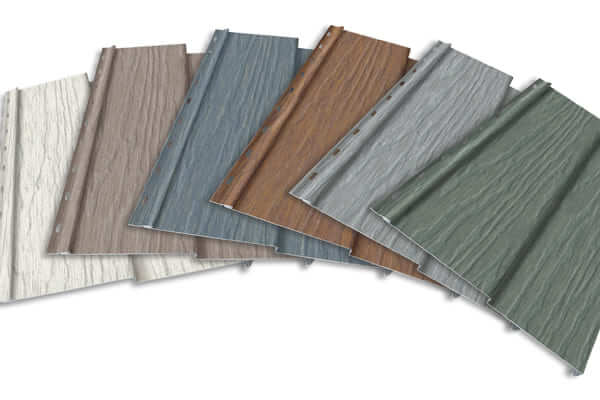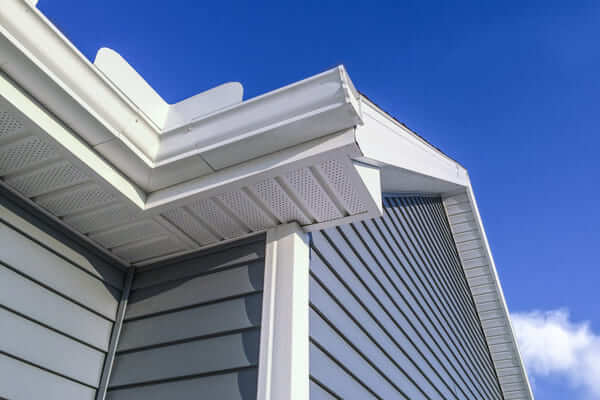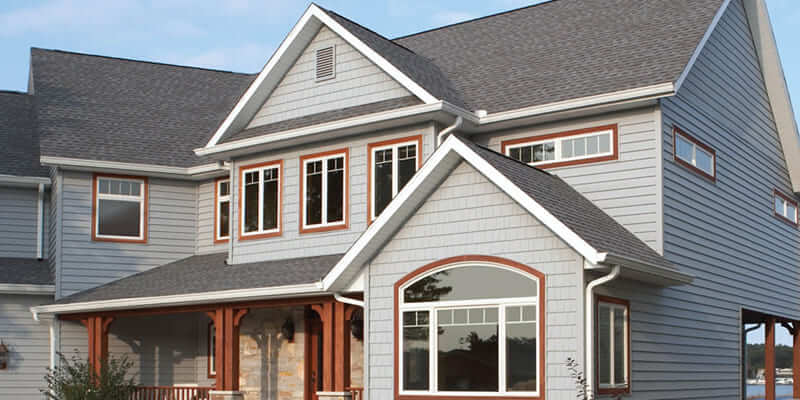Aluminum siding is a type of exterior cladding or covering used on the outer walls of buildings for protection and aesthetic purposes. It is made from sheets of aluminum that are formed into panels and designed to cover the exterior surface of a structure.
Aluminum siding is a type of exterior cladding or covering used on the outer walls of buildings for protection and aesthetic purposes. It is made from sheets of aluminum that are formed into panels and designed to cover the exterior surface of a structure. The sheets are often textured and coated with paint or another finish to enhance both appearance and durability.

Aluminum siding
Aluminum siding became popular in the mid-20th century as an alternative to traditional materials like wood or vinyl.
Aluminum siding is typically made from aluminum alloys that are chosen for their specific properties, including durability, জারা প্রতিরোধ, and ease of forming. The alloys used in aluminum siding may vary by manufacturer and product specifications. Here are some common aluminum alloys used in siding:
3003 খাদ:
এই খাদটি তার চমৎকার জারা প্রতিরোধের জন্য পরিচিত, making it suitable for outdoor applications like siding. It is also relatively formable, allowing for the creation of various siding profiles.
3105 খাদ:
অনুরূপ 3003, 3105 অ্যালুমিনিয়াম খাদ is often used in applications requiring corrosion resistance. It is also known for its good formability and is commonly used in the construction industry.
5005 খাদ:
This alloy is chosen for its high corrosion resistance and suitability for outdoor applications. It has good welding characteristics, which can be important during the manufacturing and installation processes.
5052 খাদ:
5052 is known for its strength and excellent corrosion resistance. It is commonly used in marine applications due to its resistance to saltwater corrosion. While it’s not as formable as some other alloys, it is still used in certain siding applications.
6061 খাদ:
While not as common in siding as some other alloys, 6061 is known for its strength and good machinability. It may be used in specialized siding products or in areas where higher strength is required.
6063 খাদ:
6063 is often used in extruded aluminum products, including some types of siding. It has good extrudability and is well-suited for shaping and forming.

Aluminum siding application
Alloys with Magnesium and Silicon:
Some aluminum alloys contain elements like magnesium and silicon to enhance specific properties. উদাহরণস্বরূপ, the addition of magnesium can improve strength, while silicon helps with formability. খাদ পছন্দ 6000 series may fall into this category.
It’s essential to note that the specific alloy used in aluminum siding can vary based on factors such as the desired performance characteristics, manufacturing processes, এবং খরচ বিবেচনা. Manufacturers may have proprietary blends or specific alloy choices for their products.
When choosing aluminum siding, it’s advisable to consult with the manufacturer or supplier to understand the alloy composition and its suitability for the intended application, taking into account factors like climate, exposure to the elements, and desired aesthetic features.
The application of aluminum siding involves the installation of aluminum panels or sheets onto the exterior walls of a building. Here’s a general overview of the process:
প্রস্তুতি:
Before starting the installation, the existing siding or wall surface may need to be prepared. This can include removing any old siding, repairing damaged areas, and ensuring a clean and even surface for the new aluminum siding.

Aluminum siding application display
Measuring and Cutting:
Accurate measurements of the walls are crucial to ensure that the aluminum siding fits properly. The panels may need to be cut to the appropriate size using tin snips, a circular saw, or another suitable cutting tool.
Flashing Installation:
Install flashing around windows, দরজা, corners, and other openings to prevent water infiltration. Flashing helps direct water away from vulnerable areas.
Starter Strip:
A starter strip is typically installed at the base of the wall to provide a level and straight starting point for the first row of siding panels.
First Row Installation:
Begin installing the first row of aluminum siding panels along the starter strip. Each panel usually interlocks with the adjacent ones. Fasten the panels to the wall using nails or screws, leaving a small gap to accommodate expansion and contraction due to temperature changes.
J-Channel and Trim Installation:
Use J-channels around windows and doors to receive the cut edges of the siding panels. Install corner posts and other trim pieces as needed for a finished look. These components not only enhance aesthetics but also help secure the siding.
Overlap and Interlock:
Ensure that each subsequent row of siding overlaps and interlocks with the row below it. This interlocking design helps create a weather-resistant barrier.
Ventilation and Insulation:
যদি প্রয়োজন হয় তাহলে, install ventilation and insulation materials. Some aluminum siding products have built-in insulation or require additional insulation layers to enhance energy efficiency.
Soffit and Fascia Installation:
Install soffit panels under the eaves and fascia boards along the roofline. These components provide a finished look and protect the roof overhang.
Final Inspection:
After completing the installation, conduct a thorough inspection to ensure that all panels are securely fastened, seams are properly aligned, and any necessary finishing touches are in place.
It’s important to follow the manufacturer’s guidelines and recommendations for installation to ensure the best performance and longevity of the aluminum siding. উপরন্তু, hiring experienced professionals for installation can help avoid common pitfalls and ensure a well-executed application.
Cost is definitely a factor in aluminum siding’s favor. It’s slightly cheaper than vinyl, fiber cement and stucco, and much cheaper than brick, stone and wood.
Here are some other reasons to choose aluminum over other siding options:
For many people, the main drawback of aluminum is its appearance, which can be dated and industrial. Cognizant of that, manufacturers have tried to make aluminum more closely resemble wood, imprinting the panels with a grain and finishing them with earth-tone colors. This hasn’t eliminated the stigma for everyone, যাহোক.
Besides its appearance, aluminum has other significant drawbacks:
China is the core country for the production and export of aluminum alloy products. The aluminum alloy siding produced in China not only has excellent quality, but also has great price discounts.
হুয়াওয়ে অ্যালুমিনিয়াম is a high-quality aluminum product manufacturer in China. We insist on the production and export of high-quality aluminum alloy products (including Aluminum Siding), adhere to the customer-centered approach, create high-quality services, and ensure that users can purchase high-quality products at the lowest price.
If you need Aluminum Siding, আমাদের সাথে যোগাযোগ করুন, our business will provide you with the best price.
হুয়াওয়ে অ্যালুমিনিয়াম অ্যালুমিনিয়াম ডিস্ক ব্যাপকভাবে ঘানায় রপ্তানি করা হয়, গুয়াতেমালা, বুরকিনা ফাসো, আলজেরিয়া, Togo, কেনিয়া, নাইজেরিয়া, দক্ষিন আফ্রিকা, মরক্কো এবং অন্যান্য আফ্রিকান দেশ; সংযুক্ত আরব আমিরাত, ইয়েমেন, কাতার, কুয়েত, ইরান, জর্ডান, সৌদি আরব এবং মধ্যপ্রাচ্যের অন্যান্য দেশ.
পাতলা অ্যালুমিনিয়াম শীট সাধারণত অ্যালুমিনিয়াম উপাদানের একটি সমতল টুকরো বোঝায় যার পুরুত্ব 6 মিমি এরও কম (0.24 ইঞ্চি).
6061 অ্যালুমিনিয়াম কয়েল" একটি অ্যালুমিনিয়াম খাদ যা সাধারণত স্বয়ংচালিত এবং মহাকাশ উপাদানগুলির মতো অ্যাপ্লিকেশনগুলির জন্য ব্যবহৃত হয়, সেইসাথে নির্মাণ এবং শিল্প পণ্য জন্য. এই নিবন্ধটি বৈশিষ্ট্য অন্বেষণ করবে,এর সুবিধা এবং অ্যাপ্লিকেশন 6061 অ্যালুমিনিয়াম কয়েল, তার কাঁচামাল ফর্ম থেকে সমাপ্ত পণ্য.
হাইড্রোফিলিক অ্যালুমিনিয়াম ফয়েল অ্যালুমিনিয়াম ফয়েলের পৃষ্ঠকে হাইড্রোফিলিক আবরণ দিয়ে আবরণ করে প্রাপ্ত হয়, উদ্দেশ্য হাইড্রোফিলিক উন্নত করা (জল-আকর্ষক) অ্যালুমিনিয়াম ফয়েল কর্মক্ষমতা, এবং এটি উচ্চ তাপ স্থানান্তর দক্ষতা এবং জারা প্রতিরোধের আছে.
উপলব্ধ বিভিন্ন অ্যালুমিনিয়াম alloys মধ্যে, দ্য 2014 অ্যালুমিনিয়াম প্লেট নিজের জন্য একটি কুলুঙ্গি খোদাই করেছে, বিশেষ করে উচ্চ শক্তি দাবি করা অ্যাপ্লিকেশনগুলিতে, চমৎকার machinability, এবং ক্লান্তি প্রতিরোধ.
কম্পোজিট অ্যালুমিনিয়াম ফয়েল হল অ্যালুমিনিয়াম ফয়েল এবং অন্যান্য উপকরণের সমন্বয়ে গঠিত একটি কার্যকরী উপাদান. এটির বিভিন্ন বৈশিষ্ট্য যেমন অ্যান্টিঅক্সিডেন্ট রয়েছে, তাপ প্রতিরোধক, জারা প্রতিরোধ, এবং তাপ নিরোধক
নং 52, ডংমিং রোড, ঝেংঝো, হেনান, চীন
হেনান হুয়াওয়ে অ্যালুমিনিয়াম কো., লিমিটেড, চীন হেনানের বৃহত্তম অ্যালুমিনিয়াম সরবরাহকারীর মধ্যে একটি,আমরা 2001 সালে প্রতিষ্ঠিত, এবং আমাদের আমদানি ও রপ্তানি এবং উচ্চ মানের অ্যালুমিনিয়াম পণ্যগুলিতে সমৃদ্ধ অভিজ্ঞতা রয়েছে
সোম-শনি, 8AM - 5PM
রবিবার: বন্ধ
© কপিরাইট © 2023 হেনান হুয়াওয়ে অ্যালুমিনিয়াম কো., লিমিটেড
সর্বশেষ মন্তব্য
জনাব, Please offer your best FOB Prices specs are as under ALUMINIUM STRIP (AL=99.50% মিনিট) SIZE:450 X32 X6 MM. আপনার এক 570 EN-AW 1050 ক, পরিমাণ = 3400 কেজি
হ্যালো, আপনি নিম্নলিখিত হিসাবে আইটেম অফার তাই দয়ালু হবে: কয়েল 0,6х1250 (1000)mm EN AW-3105 5tons
হ্যালো, আপনি আমাকে অ্যালুমিনিয়াম প্লেট দিতে পারেন?? আসলে আমার দরকার: 110মিমি x 1700 মিমি x 1700 মিমি 5083 H111 - 21 pcs Next year planed is 177 পিসি
মহান নিবন্ধ. আমি প্রসন্ন ছিলাম, যে আমি এই নিবন্ধটি খুঁজে পেয়েছি. অনেকেই তাই মনে করেন, যে তারা এই বিষয়ে নির্ভরযোগ্য জ্ঞান আছে, কিন্তু এই প্রায়ই ক্ষেত্রে হয় না. তাই আমার আনন্দদায়ক বিস্ময়. আমি অভিভূত. আমি অবশ্যই এই জায়গাটি সুপারিশ করব এবং আরও প্রায়ই ফিরে আসব, নতুন জিনিস দেখতে.
অ্যালুমিনিয়াম ফালা প্রয়োজন